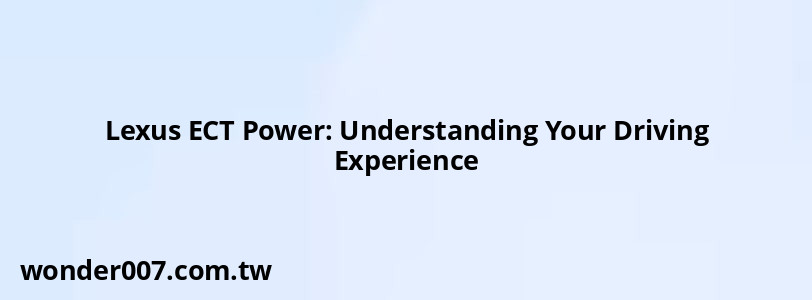Lexus ECT Power: Understanding Your Driving Experience

Lexus vehicles are renowned for their luxury and performance, and one feature that enhances this experience is the ECT Power mode. This mode is designed to optimize your driving by adjusting the vehicle's transmission settings for improved responsiveness and acceleration.
What is ECT Power?
ECT stands for Electronically Controlled Transmission. The ECT Power mode allows drivers to engage a setting that alters the vehicle's shifting characteristics. When activated, this mode changes the shift points of the transmission, allowing it to hold lower gears longer and shift at higher RPMs. This results in:- Quicker acceleration: The engine revs higher before shifting, providing more power when needed.
- Improved throttle response: The gas pedal becomes more sensitive, making the vehicle feel more agile.
- Enhanced performance on inclines: It helps in maintaining speed and power when driving uphill or during overtaking maneuvers.
Using ECT Power can significantly enhance your driving experience, especially in situations requiring quick acceleration or when navigating challenging terrains.
How to Use ECT Power
The ECT Power feature is typically controlled by a button located near the gear shift. Engaging this mode is straightforward:
- Press the ECT Power button: This activates the power mode, indicated by a light on the dashboard.
- Monitor your driving conditions: While this mode offers enhanced performance, it may lead to increased fuel consumption. It's advisable to use it judiciously, especially in traffic or during long drives.
Benefits of Using ECT Power
Utilizing ECT Power can provide several advantages:
- Better control during acceleration: Ideal for merging onto highways or overtaking other vehicles.
- Smoother downshifting: Particularly beneficial when driving on steep hills or curvy roads.
- Enhanced driving enjoyment: The increased responsiveness makes for a more engaging driving experience.
However, it's essential to be mindful of fuel efficiency, as using this mode consistently can lead to higher fuel consumption.
When to Avoid ECT Power
While ECT Power can enhance performance, there are scenarios where it may not be ideal:
- In heavy traffic: Constantly engaging higher RPMs can lead to unnecessary fuel waste.
- During regular city driving: Normal mode is often more fuel-efficient for everyday commutes.
By understanding when to use and when to avoid ECT Power, you can optimize your Lexus's performance while maintaining good fuel economy.
FAQs About Lexus ECT Power
- What does the ECT Power light indicate?
The light indicates that the ECT Power mode is active, altering the vehicle's transmission settings. - Does using ECT Power increase horsepower?
No, it does not increase horsepower but changes how the transmission responds to throttle input. - Can I use ECT Power all the time?
While you can use it frequently, it's best reserved for situations requiring enhanced performance due to its impact on fuel consumption.
Understanding how to effectively utilize Lexus's ECT Power feature can greatly enhance your driving experience while ensuring you maintain control over your vehicle's performance and efficiency.
Related Posts
-
Warning Lights: Understanding Your Car's Dashboard Symbols
29-01-2025 • 241 views -
AC Blows Cold at Idle, Warm When Driving
27-01-2025 • 89 views -
Kia Sorento: Understanding Oil Filter Housing Leaks
28-01-2025 • 228 views -
CV Axle Popped Out While Driving: Causes and Solutions
30-01-2025 • 207 views -
Kia Soul: Understanding ABS and Traction Control Lights
27-01-2025 • 155 views
Latest Posts
-
Rear Brake Caliper Piston Won't Compress
01-02-2025 • 300 views -
Are O2 Sensors Covered Under Warranty
01-02-2025 • 326 views -
2015 Chevy Traverse AC Recharge Port Location
01-02-2025 • 354 views -
Power Steering Fluid Leak On Passenger Side
01-02-2025 • 407 views -
How To Turn Off Paddle Shifters Mercedes
01-02-2025 • 320 views
Popular Posts
-
V12 Engine Costs: What You Need to Know
26-01-2025 • 610 views -
Hino Warning Lights: Understanding Dashboard Alerts
26-01-2025 • 591 views -
EPC Warning Light: What It Means for Your Vehicle
27-01-2025 • 577 views -
EPC Light: Understanding Causes and Solutions
26-01-2025 • 1015 views -
Power Steering and ABS Light On: Causes and Solutions
27-01-2025 • 595 views
